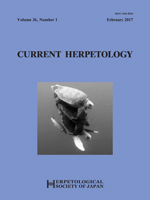Populations of the montane brown frog, Rana ornativentris, endemic to Japan, have been declining abruptly due to habitat loss and destruction by land development, and thus genetic diversity of this species is needed for clarifying the demographic status and conservation measures of this species. However, there were no appropriate genetic markers to elucidate such genetic diversities in population and individual level. We therefore developed microsatellite markers of R. ornativentris utilizing Ion PGM™ sequencing. As a result of the screening, a total of 23 polymorphic markers were developed. To test the usefulness of these markers for population genetic analysis, we genotyped two regional populations: an eastern population (Akiruno-shi, Tokyo) and a western population (Kita-hiroshima-cho, Hiroshima Pref.). The total number of alleles and expected heterozygosities per locus ranged from 3 to 11 and 0.000 to 0.875, respectively. The markers described here will be useful for studying population genetics and planning conservation managements of R. ornativentris.
How to translate text using browser tools
1 February 2017
Development and Characterization of 23 Microsatellite Markers for the Montane Brown Frog (Rana ornativentris)
Hisanori Okamiya,
Takeshi Igawa,
Masafumi Nozawa,
Masayuki Sumida,
Tamotsu Kusano
ACCESS THE FULL ARTICLE

Current Herpetology
Vol. 36 • No. 1
February 2017
Vol. 36 • No. 1
February 2017
conservation genetics
microsatellite markers
population genetics
Rana ornativentris




